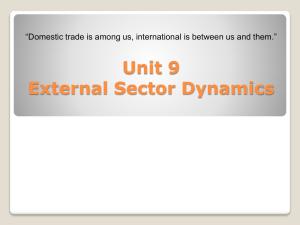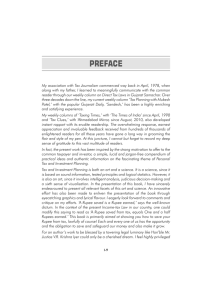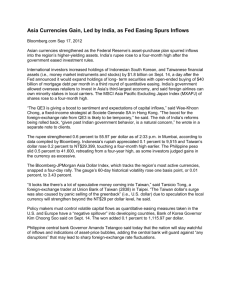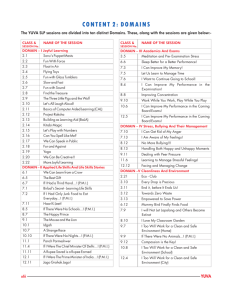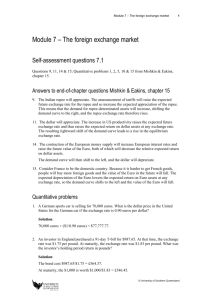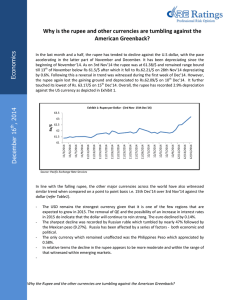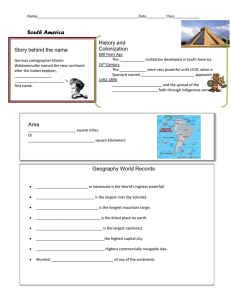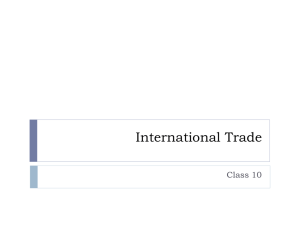Exchange Rate Movement in FY16
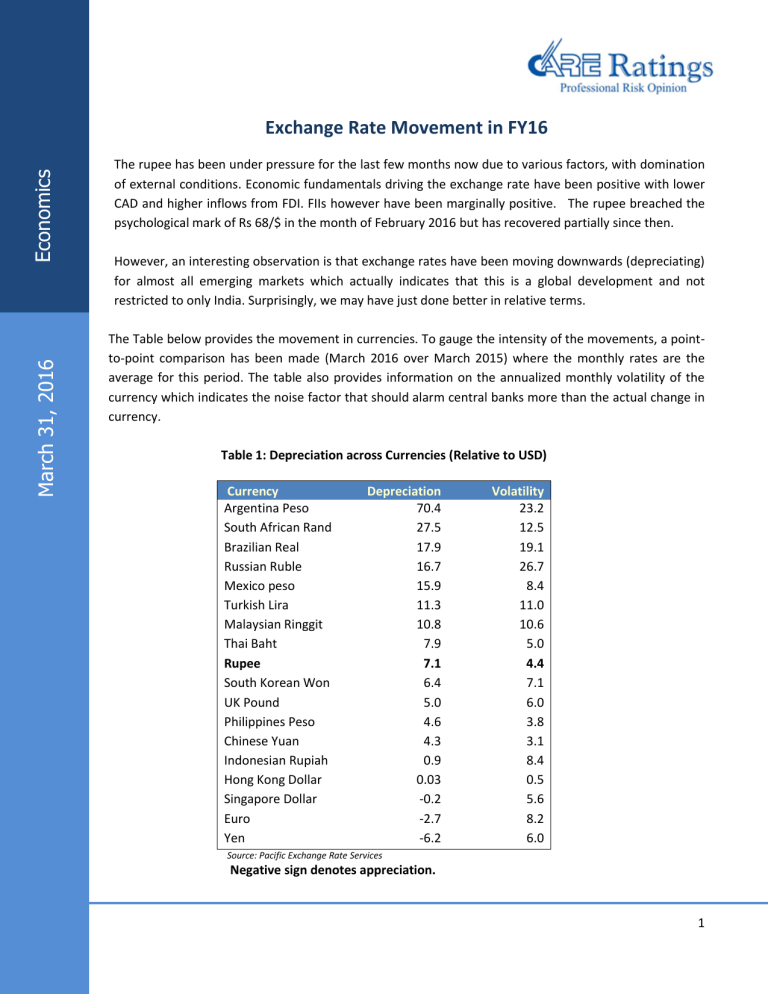
Exchange Rate Movement in FY16
The rupee has been under pressure for the last few months now due to various factors, with domination of external conditions. Economic fundamentals driving the exchange rate have been positive with lower
CAD and higher inflows from FDI. FIIs however have been marginally positive. The rupee breached the psychological mark of Rs 68/$ in the month of February 2016 but has recovered partially since then.
However, an interesting observation is that exchange rates have been moving downwards (depreciating) for almost all emerging markets which actually indicates that this is a global development and not restricted to only India. Surprisingly, we may have just done better in relative terms.
The Table below provides the movement in currencies. To gauge the intensity of the movements, a pointto-point comparison has been made (March 2016 over March 2015) where the monthly rates are the average for this period. The table also provides information on the annualized monthly volatility of the currency which indicates the noise factor that should alarm central banks more than the actual change in currency.
Table 1: Depreciation across Currencies (Relative to USD)
Currency
Argentina Peso
Depreciation
70.4
Volatility
23.2
South African Rand
Brazilian Real
Russian Ruble
Mexico peso
27.5
17.9
16.7
15.9
12.5
19.1
26.7
8.4
Turkish Lira
Malaysian Ringgit
Thai Baht
Rupee
South Korean Won
UK Pound
Philippines Peso
Chinese Yuan
Indonesian Rupiah
Hong Kong Dollar
Singapore Dollar
0.03
-0.2
Euro -2.7
Yen -6.2
Source: Pacific Exchange Rate Services
Negative sign denotes appreciation.
11.3
10.8
7.9
7.1
6.4
5.0
4.6
4.3
0.9
11.0
10.6
5.0
4.4
7.1
6.0
3.8
3.1
8.4
0.5
5.6
8.2
6.0
1
Economics
The table shows that:
15 of the 18 currencies covered here witnessed depreciation during this period. Of these 10 have declined by more than 5%, with the Argentina Peso witnessing the highest decline, followed by South African Rand and Brazilian Real. Russian Ruble (16.7%) and Mexico Peso (15.9%) also witnessed high level of depreciation. The rupee performance was better at 7.1%.
Hong Kong Dollar and Indonesian Rupiah depreciated by less than 1%
Further, 6 out of the 18 currencies witnessed annualized volatility of more than 10%. Rupee registered lower volatility of 4.4%.
Higher annualized monthly volatility was witnessed also in the currencies which depreciate at sharper rates.
Singapore Dollar, Euro and Yen witnessed appreciation during the period. It also needs to be noted than the currencies with appreciation also had lower volatility (less than 10%). Hong Kong dollar remained unchanged and also was very stable during this period in terms of volatility.
What will drive the rupee now?
The rupee has been fairly stable based on the fundamentals, but one cannot escape the impact of the global influences such as strength of the dollar.
The rupee will be driven by a combination of the dollar impact and the fundamentals. Any strengthening of the dollar will necessarily mean a weaker rupee in the absence of RBI intervention.
Daily FPI flows will provide direction to the rupee. Debt flow in particular would be influenced by two factors: o The space provided by the limits that are available for FPI to operate in the GSec/SDL market.
Recently the RBI has increased the limits for investment by FPIs in Central Government Securities for the next half year in two tranches, i.e., by Rs. 105 billion from April 4, 2016 and by Rs.100 billion from July 5, 2016 respectively. As in the previous half-year, the limits for State
Development Loans (SDL) are proposed to be increased in two tranches, each of Rs.35 billion, from April 4, 2016 and July 5, 2016 respectively. o The Fed rate hike - Presently, it does appear that the Fed is going to be cautious with the rate hike, thus causing lesser outflow of funds from the emerging markets.
Other fundamentals such as trade deficit and invisible flows would tend to remain stable.
Our View
Any volatility in the rupee in recent times has mainly been on account of external factors and sentiments while the fundamentals have been quite stable. A fair range for the rupee would be between Rs 66-67/$, and while there could be downward (depreciation) movements across this band, it should mean revert to this mark. As trade and current account deficit may be expected to remain well under control and FDI continues to be strong, a return to this mark can be expected.
Exchange Rate Movement
2
Economics
Contact:
Madan Sabnavis
Chief Economist
madan.sabnavis@careratings.com
Anuja Shah
Economist
91-022-67543489 anuja.jaripatke@careratings.com
91-022-61443568
Disclaimer
This report is prepared by the Economics Division of Credit Analysis &Research Li mited [CARE]. CARE has taken utmost care to ensure accuracy and objectivity while developing this report based on information available in public domain. However, neither the accuracy nor completeness of information contained in this report is guaranteed. CARE is not responsible for any errors or omissions in analysis/inferences/views or for results obtained from the use of information contained in this report and especially states that CARE
(including all divisions) has no financial liability whatsoever to the user of this report.
Exchange Rate Movement
3
